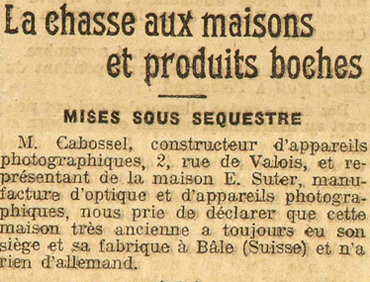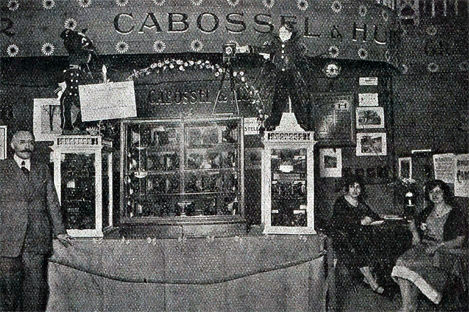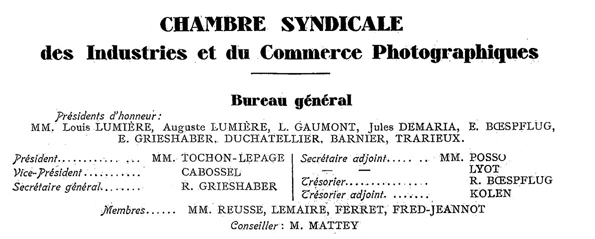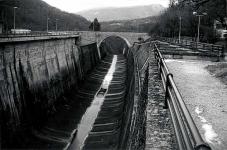|
Cabossel et Hude - |
Manufactured or assembled in France from (Circa) 1931 to (After) 1931.
Index of rarity in France: Rare (among non-specialized garage sales)
Inventory number: 6748
See the complete technical specifications
Chronology of cameras Cabossel et Hude
Cabossel et Hude was an active manufacturer of cameras for nearly thirty years, albeit lacking in great originality. Despite this longevity, the company and its products remain relatively unknown. This lack of recognition for the cameras can be attributed to the fact that some of them were sold under other brands. Overall, these cameras have few distinctive features, excluding a folding stand shaped like the Eiffel Tower, and it is uncertain whether all Cabossel and Hude folding cameras were equipped with this stand.
A few press articles allow us to learn a few small details about this company, also known as Manufacture d'Appareils Photographiques Cabossel & Hude.
In 1905, Maurice Cabossel (1876-1959), along with Mr. R. Zehnder (from Switzerland), took over the workshops of Cadot at 76 Rue d'Anjou, Paris, and continued the construction of certain models.
They moved at the end of 1913 to Rue de Valois.

They also acted as representatives of E. Suter, a Swiss manufacturer.

We note that the name Zehnder disappeared in November 1914.
Starting from February 13, 1914, Cabossel is associated with Hude, without further details on the reason for the split between Cabossel and Zehnder. It's only known that Zehnder returned to Switzerland.
During the 1920s and 1930s, "Cabossel et Hude" were present at photography exhibitions.
 |
| 1926 Stand Cabossel and Hude at the IVth Exhibition of Photography and Cinematography. |
CABOSSEL and HUDE (Etablissements), 2 Rue de Valois, Paris. — Like in previous years, the stand of the Etablissements Cabossel et Hude was particularly visited by all resellers, and numerous orders for cameras from their various series were recorded by this company. But the big success of this year was undoubtedly "La Minerva," for plates and 9 x 12 films. This extra-thin folding, a marvel of precision and elegance, is equipped with a double extension and all the latest improvements; it is mounted with F. 6.3 and F. 4.5 lenses from all major French brands; it is the luxury folding, ideal for experienced amateurs. The "Piquita" and "Dyna" for 7 x 11 films and 6 x 9 plates were also highly requested. We are pleased to note, to the credit of French manufacturing, that it is the improvements and careful construction of cameras from this company that have earned it a serious reputation and a just reputation. |
 |
| 1932 IXth Exhibition of Photography. |
During the 1930s, Cabossel appears as the vice-president of the Chambre Syndicale des Industries et du Commerca Photographiques. In this capacity, he was decorated with the Academic Palms in 1934.

The manufacturing activity ceased before the Second World War, and only the repair workshop remained.
(with the friendly participation of Etienne Gérard)
Thanks to the valuable catalogs on the website, this camera was identified as having been produced by Cabossel and Hude, a relatively unknown French firm. It is very similar to the Dyna model, which has a double draw.
It is a fairly large folding camera (22 cm high and 10 cm wide), for both roll film (6.5 x 11) and plates (6.5 x 9) thanks to a sliding opening in the back to insert the holders. It is made of wood covered with leatherette. The back and the folding are made of metal. The bellows are made of a particular leather, with an appearance resembling suede.
The shutter is a Prima, which was a Cabossel and Hude production (T, B, 100 to 10), and the lens is a Stylor Roussel 6.3 x 120. The apertures range from 6.3 to 45. The lens can be vertically shifted.
Although the camera is technically ordinary for its time, it has several distinctive elements that could be used for brand identification: the characteristic design of the stand, the shape of the winding knob, and the recessed back opening button. The small, clear, vertically shaped viewfinder is also uncommon. The handle, made of leather and metal, is original and well-made.
The film loading system is also specific, with two small metal "cages" that can be completely removed from the camera body and into which the spools are inserted before easily reinserting them.
Finally, an astonishing construction element - certainly betraying a small-scale production - several components are screwed rather than riveted and can be easily disassembled; for instance, the folding on the camera body and, never seen elsewhere, the metal frame that holds the back of the bellows is held by 6 screws and allows the bellows to be removed through the back of the camera once separated from the front plate. This proved useful for refurbishing this folding camera.
In the end, one can feel that laborious efforts to find originality... result in a somewhat unconvincing outcome.

Interesting links or bibliography :
Add a link or element of bibliography, a picture taken with this camera, a picture of box or an ads about this camera
Your photos taken with the same camera:
Cameras from Ebay France (Cabossel et Hude) (Uploaded each 3 hours)








